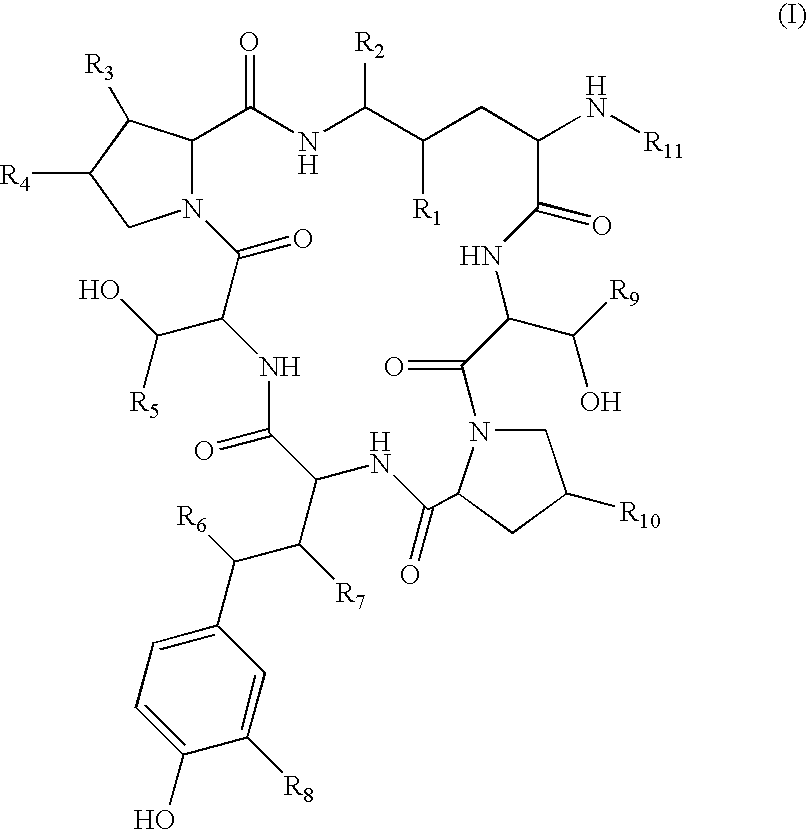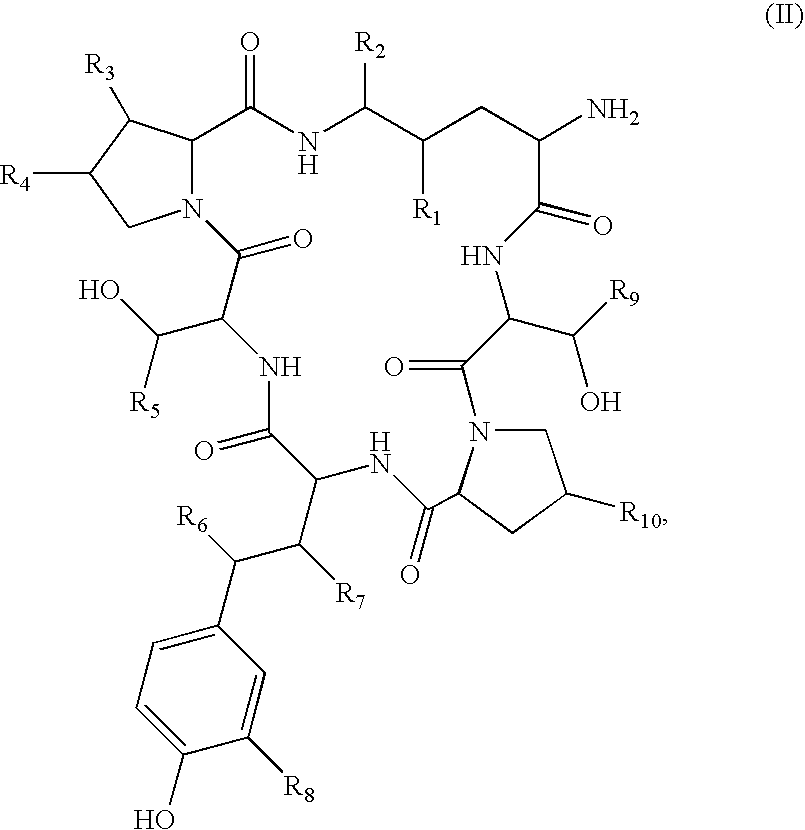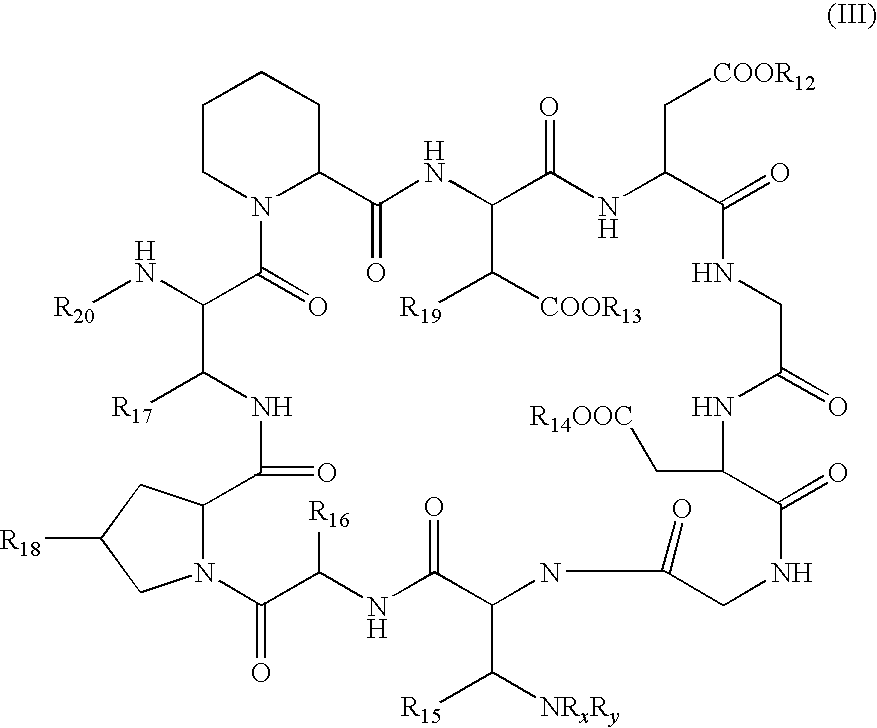Method for the deacylation of lipopeptides
a lipopeptide and lipopeptide technology, applied in the field of lipopeptide deacylation, can solve the problems of lipopeptides with unfavorable physicochemical properties, damage to the venous endothelium, tissue destruction and inflammation, and local toxic effects,
- Summary
- Abstract
- Description
- Claims
- Application Information
AI Technical Summary
Benefits of technology
Problems solved by technology
Method used
Image
Examples
example 1
Preparation of the Recombinant Deacylase Producer
[0068]A DNA fragment coding for the deacylase was isolated from the strain Actinoplanes utahensis NRRL 12052. The fragment was cloned (plasmid pCS1) and subcloned (plasmid pCS2), and the plasmid pCS2 was transformed into a S. lividans strain. Spore suspensions were prepared from a single colony of the recombinant S. lividans strain and were stored in ampoules at −20° C.
[0069]Cloning of the deacylase: the chromosomal DNA from Actinoplanes utahensis NRRL 12052 was isolated, digested with EcoRI and BglII and separated on an agarose gel, and DNA fragments with a length of 7-9 kb were isolated and cloned into the plasmid pUC19 (EcoRI / BamHI cleavage site). The ligation was transformed into E. coli, and 250 resulting ampicillin-resistant clones (50 μg / ml) were investigated by PCR. The primers were synthesized on the basis of the published DNA sequence of the deacylase (see GenBank Nucleotide Sequence Database Accession Number D90543; J. Inok...
example 2
Preparation of the Deacylase by Fermentation
[0074]A recombinant Streptomyces lividans strain as described in Example 1 was used to produce the enzyme. Such a strain can be cultivated in a batch or fed-batch fermentation. The normal process chain comprised a preculture (TSB medium) in a shaken flask, which was incubated at 28° C. and 220 rpm for three days. This flask can be used for direct inoculation of a fermenter of up to 2000 L (0.15-6% v / v inoculum). It is also possible as an alternative to insert a second preculture on the 10-50 L scale into the process chain in order, by increasing the inoculum, to speed up the initial rate of growth in the main stage.
[0075]Preparation of the enzyme by fermentation: the Spores were Reactivated by Slowly thawing a tube of an ampoule. 200 μl of the resulting suspension were used for sterile inoculation of an Erlenmeyer flask which contained 500 ml of the following medium [plus 10 μg / ml thiostreptone (50 mg / ml DMSO)]:
[0076]Preculture medium: TSB...
example 3
Deacylase Activity Determination
[0086]To monitor the enzymic activity during the preparation of the deacylase by fermentation, during the isolation of the enzyme or during the enzymatic side-chain elimination from lipopeptides such as deoxymulundocandin, the following enzymatic rapid assay was used:
[0087]20 μL of a sample containing the deacylase are added to 500 μL of a solution, preheated to 60° C., of 2.5 g / L deoxymulundocandin (V), 0.5% v / v Brij 35 in 200 mM sodium phosphate buffer (pH 5.5). The solution is incubated at 60° C. with shaking for 10 minutes. The deacylation is then stopped by adding 480 μL of 0.85% v / v phosphoric acid.
[0088]After centrifugation and removal of insoluble constituents, the amount of the deoxymulundocandin nucleus (VI) formed is determined in an accompanying HPLC analysis. For this purpose, 5 μL of the solution are injected onto a Merck Purospher Star RP column (4*55 mm) and eluted with a three-minute linear gradient of 4→20% v / v acetonitrile acidified...
PUM
| Property | Measurement | Unit |
|---|---|---|
| pH | aaaaa | aaaaa |
| pH | aaaaa | aaaaa |
| pH | aaaaa | aaaaa |
Abstract
Description
Claims
Application Information
 Login to View More
Login to View More - R&D
- Intellectual Property
- Life Sciences
- Materials
- Tech Scout
- Unparalleled Data Quality
- Higher Quality Content
- 60% Fewer Hallucinations
Browse by: Latest US Patents, China's latest patents, Technical Efficacy Thesaurus, Application Domain, Technology Topic, Popular Technical Reports.
© 2025 PatSnap. All rights reserved.Legal|Privacy policy|Modern Slavery Act Transparency Statement|Sitemap|About US| Contact US: help@patsnap.com



